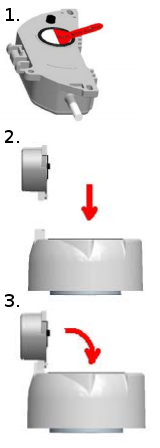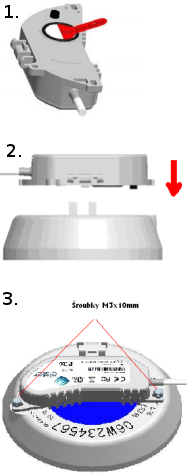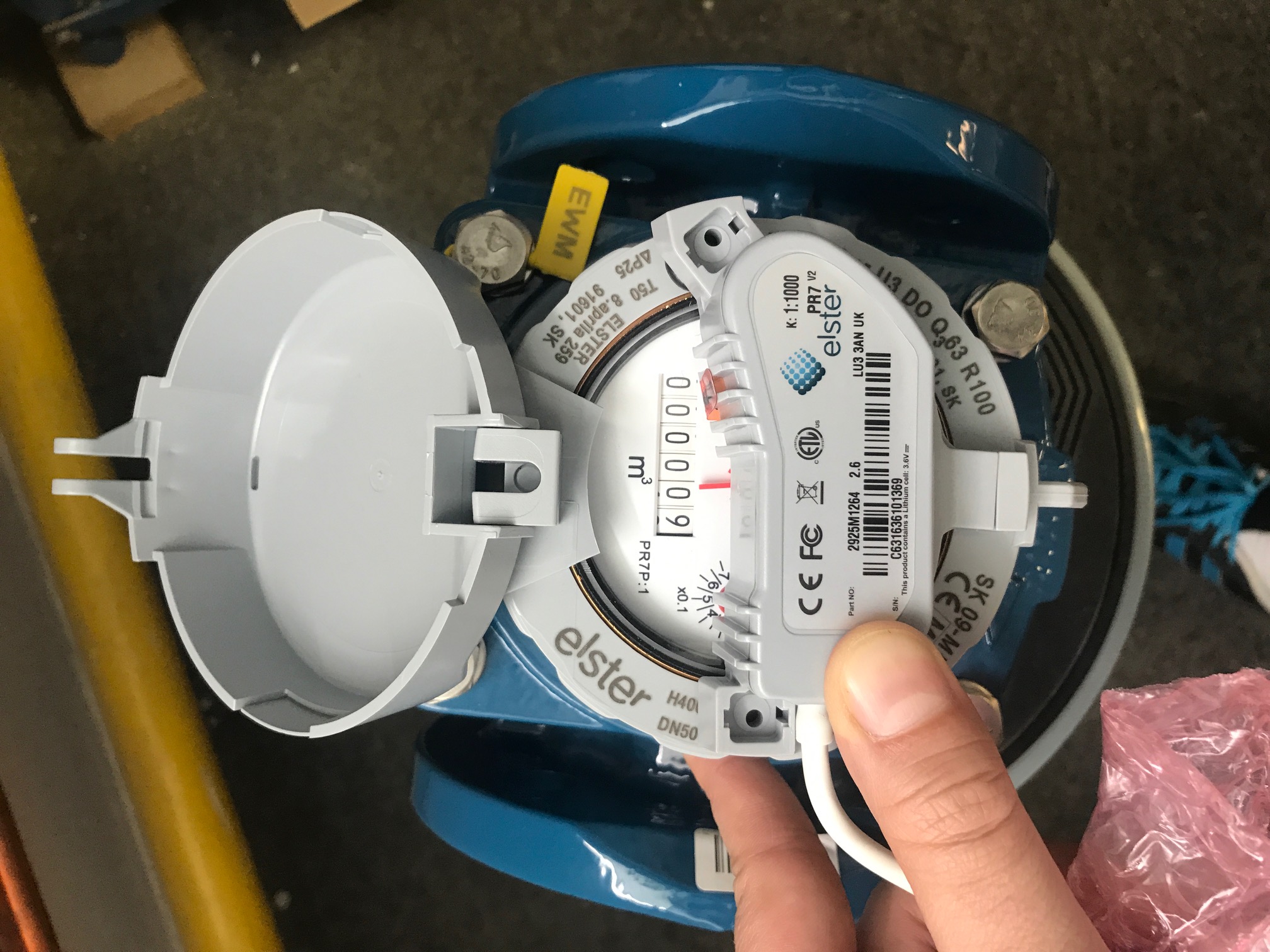The PR6 and PR7 pulse modules are used for reading Elster water meters.
The PR6 sensor is designed for domestic water meters R ½" - 2" type V200, V200P, V220, C4000 (small water meter marked V220) Sensor PR7 is designed for industrial water meters DN 40 - DN 300 , type H4000, H4200, S2000, C4000 ( main counter ), C3100 (main counter since 2008)
Installation of PR6 modules
PR6 - V200
- Tear off the foil
- Remove the counter cap, attach the PR6 to the cap pin
- Push the PR6 downward until it clicks into place. Ensure the water meter glass is clean
- Push in the two locking studs to secure

PR6 - H400P
Tear off the foil Remove the two M3 screws from the cap. Ensure that the water meter glass is clean Using a screwdriver, secure the PR6 with the two M3 screws. Ensure that the screws are tightened and the PR6 is placed in the correct position ( if the PR6 was supplied without screws use M3x10mm screws with the head not countersunk. Do not connect the PR6 to the cap hinge

PR7
Tear off the foil Place the two screws on PR7 to secure it. If access to the water meters is difficult, use a flathead screwdriver Put the locking screws on the end of the mounting aids. Grasp the mounting aid by the top end and turn as with a screwdriver to tighten the screws: if necessary use a flat head screwdriver to tighten.

They are applicable for the following types of water meters:
-
PR6: V200, V210, V220F, C4000
-
PR7: H4000, H4200, S2000, C4000 Main Counter, C3100 Main Counter from 2008 onwards
Generally PR6 is used for smaller flow rates, PR7 for higher flow rates.
Example of correctly installed water meter module

The module is installed so that the status indicator on the water meter remains visible.
Cable connection

-
CH1P (yellow) Forward and reverse output pulses (must always be connected)
-
CH1D (white) Signals the direction of flow (on=forward flow)
-
CH2P (red) Difference between forward and reverse flow. This pulse of current compensates for any backflow. No pulses are sent to the sensor output during reverse flow. When forward flow is restored, the pulses stored in the sensor memory are first cleared. These pulses are first subtracted from the previous backflow. Only after the entire memory with the stored backflow pulses has been erased, the pulses are again sent to the sensor output.
-
CH2C (green) Indicates the direction of flow (open=backflow or low flow)
-
TAMP (brown) Signals (by switching the circuit) the disconnection of the pulse meter from the water meter, or low battery.
-
GND (black) common cable for all types of wiring (must always be connected)
Standard reading is the difference between forward and reverse flow (CH2), i.e. červený (+) a black (-) driver.
The weight of one pulse corresponds to the product of the value indicated on the module and on the water meter.
Weight of pulses
The modules generate pulses corresponding to the volume flowed. The weight of one pulse is the product of the pulse P-factor of the water meter and the K-factor of the module.
Water meter pulse factor
The pulse factor of the water meter can be found on the water meter along with the type designation of the applicable module. For example, a water meter marked PR7 P:1 can be used with a PR7 module and its pulse factor following the letter P is 1 litre. The designation PR7 P:10 then indicates a water meter pulse factor of 10 litres.
Module K-factor
Most PR6 and PR7 have two K-factors because the counters have two outputs. These factors are marked on the counter, for example 1:100. The first number is the K-factor for the primary output (CH1) and the second number is the K-factor for the secondary output (CH2). In standard compensated output wiring we are interested in the second number (after the colon).
The following table shows examples of factor calculations:
| Pulse factor of water meters | Counter type | Pulse Counter Pulse Factor | Primary output CH1P (litre/pulse) | Secondary CH2P output (litre/pulse) |
|---|---|---|---|---|
| PR6 P:1 | PR6 | 1:1 | 1 | 1 |
| PR6 P:1 | PR6 | 1:10 | 1 | 10 |
| PR6 P:1 | PR6 | 1:100 | 1 | 100 |
| PR7 P:1 | PR7 | 1:- | 1 | - |
| PR7 P:1 | PR7 | 1:10 | 1 | 10 |
| PR7 P:1 | PR7 | 1:1000 | 1 | 1000 |
| PR7 P:10 | PR7 | 1:1 | 10 | 10 |
| PR7 P:1 | PR7 | 10:10 | 10 | 10 |
| PR7 P:10 | PR7 | 10:10 | 100 | 100 |
